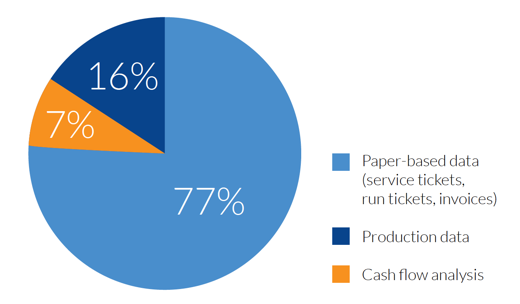
Independent oil and gas operators are facing unprecedented pressure with both oil price volatility and COVID-19 causing massive business disruptions. Operators are focusing on the safety of their teams and dealing with an increased number of shut-ins, as well as more scrutiny on their margins.
As they struggle to adapt, many companies recognize that they must transform their financial and business operating models. Specifically, they need new approaches that expedite decision making, reduce costs, and improve profitability.
Automation is increasingly a top priority. By automating financial data and revenue distribution management, companies can:
- Monitor more data in the field, which requires fewer people, reduces operating expenses (OpEx), and boosts margins;
- Enable a “work from anywhere” strategy, which is critical at a time when so many employees are now working remotely; and
- Electronically share, collaborate and transmit revenue distributions, DOIs and AFEs securely and in real time to make faster, more informed decisions.
Until recently, only the largest oil and gas companies possessed the money, staff and resources to reap the benefits of business automation solutions that optimized the data exchange between the oilfield and back-office operations. Fortunately, these benefits are now accessible to a much greater contingent of oil and gas companies, thanks to shrinking technology and cost barriers to adoption, as well as the maturity of cloud and mobile.
Independent operators can realize several key benefits by leveraging new and emerging technology advancements. They can become more agile and gain a competitive edge by digitizing their workflows for revenue distribution and financial oversight – and do it in a cost-effective, secure way.
So how can oil and gas companies leverage digital technologies as a key enabler to improve financial health and mitigate risks in a volatile market?
Revenue distribution: A digital experience for DOIs, AFEs and more
According to analysts at research firm IDC, 42% of knowledge workers said that “paper-based workflows that are highly manual make their daily tasks (document workflows) less efficient, costlier, or less productive.”
Manual processes are an anachronism in a world where employees can order food, schedule a ride, buy a couch or a car, stream Yellowstone, and conduct mobile banking from their phones.
Today’s knowledge workers are so used to on-demand digital and mobile experiences in their personal lives that they now want the same for their business tools. Information is available instantly, anytime, anywhere at home, so why not in the office?
It’s time to focus on the entire user experience.
Take, for example, managing Authority for Expenditures (AFEs). This is a critical workflow and, if it goes smoothly, can help a company accelerate business processes. If it’s slow and paper based, however, it can stifle decision making. With operators managing extensive holdings with dozens or even hundreds or owners, companies need the ability to easily create, approve, or suspend budget decisions and AFEs on the fly.
When processed manually, AFEs are time consuming and confusing to manage, so they easily go off track or over budget. Instead of having one or two people devote hours to doing everything via email, phone, and PDF documents, companies can digitize this workflow without massive disruption or expense.
The transition to digital doesn’t mean that personal communications will disappear; companies will always need people on hand to answer questions, field calls and requests, and manage the ad hoc needs of owners. The work just gets redistributed. The grunt work of gathering consensus, approvals, manually updating spreadsheets, and moving forward is now handled electronically, with full transparency into the entire process from start to finish.
Today’s independent operators also have access to valuable data analytics and reporting. Revenue analytics, visual dashboards, and electronic document management let companies manage revenue, DOIs, and AFEs with as little physical contact as possible.
Communicating and collaborating with hundreds of owners can happen instantly. Operators can see the status of approvals immediately and also suspend orders on-demand in a near contactless environment. The company isn’t the only beneficiary; your employees and owners will thank you for it.
Breaking free from paper-based processes
It is difficult, if not impossible, for a business to function via a paper trail in a world on lockdown that is slowly trying to transition safely back to the physical office and in the field, minus essential workers. The oil-patch version of a file transfer protocol has long been hand-written documents or revenue information passed off to someone in data-entry.
These manual processes require physical interoffice transfers, with someone picking up a piece of paper and entering the data by hand into one or more different systems. Manual data entry is inefficient, time-consuming, and error-prone.
Despite all the drawbacks, paper-based processes still consume an incredible amount of time and resources, not only in this industry but in many others. IDC data shows just how entrenched paper is in today’s office environment: Nearly all external communications are paper based, including 30% of documents used every day. In addition, nearly 70% of knowledge workers mainly use email to distribute documents to company stakeholders. So much for inbox zero if team members need to keep track of AFEs, invoices, and approvals via email messages.
Couple these statistics with the mountain of documents and files locked away in physical file cabinets and on-site storage, and you have people spending exorbitant amounts of time searching for and retrieving information. When dealing with multiple stakeholders, owners, and partners, the complexity grows exponentially the more people have to physically touch a document.
You might expect that companies would have moved away from paper in the wake of COVID-19. That transition has started to take hold but there’s more to do. Recent customer survey data from WolfePak Software demonstrated that almost 77% of respondents struggled with paper-based processes during the transition to remote work. Simple functions — such as gaining access to revenue analytics, job tickets, invoices, receipts, and records processed — were difficult to access.

Working with paper-based processes was the biggest challenge facing teams, as employees could not easily get the data they needed to keep the business going. Key barriers companies faced included:
- Processing hard-copy checks that have been mailed to the office;
- Responding to paperwork from other divisions, government agencies, and outside operators; and
- Scanning documents into company systems.
In the current environment, manual workflows or physical file rooms are less than ideal. People are unable to get into the office to pull a file, approve an invoice or manage AFEs, process AP, file DO letters - increasing the burden on employees to figure out workarounds at home. This puts companies at risk for compliance violations and potential data breaches.
An open approach to people, processes and systems
Getting started with an electronic process does not present tremendous difficulties. However, before rushing into it, consider the many intricacies and nuances of the oil and gas industry. It’s important to take them into account when digitizing processes involving workflow and integration. You can’t address just one step in isolation. It's not only about a capture point but the entire business process.
The interesting dynamic in the oil and gas industry is the extensive interplay between the companies themselves. So much information is exchanged daily between organizations — from exploration and production companies, to operators and first purchasers, to midstream companies, and so on. That constant flow of information is inherently complex and nuanced.
So, how can technology help us work together more as an industry?
Ensuring frictionless data transfer makes more information usable on a daily basis so businesses and financial teams can focus on the right metrics and invest where they should. Helping all segments of the industry shed the manual and paper-based processes to which they are accustomed and transition to digital communication is a major focus. That’s especially urgent as many of us continue to work remotely or are slowly re-entering the office.
In order to achieve this new digital reality, companies need to commit to both open systems and technology that can communicate with each other. Integration is inherently linked with business process automation, and the extent of the integration will often dictate the degree to which a company can automate processes.
Take the seemingly simple process of paying property owners via check or electronic payments. While this may seem to be a trivial task, it is a very complex process requiring coordination between the Land, Division Order and Accounting departments. If there are different systems for each department and they do not communicate well, the business could lose important details for these transactions, complicating internal and compliance reporting.
Closed systems that are incompatible or lack native integration will stop workflows right in their tracks, causing even more complexities and introducing new problems. If there are related transactions in two different parts of the business, the technologies used to manage them must be in sync so they can distribute all the critical details to all departments. When your revenue documents and data are integrated, your system of record (ERP) can pass information back and forth, optimizing not only back-office processes but also data transfer from the oilfield.
When documents are digitized, employees working from home can log into the system from any computer with an Internet connection and access the information they need to do their jobs. The benefits aren’t limited to remote staff. When they go back to the office, they will be more efficient in this environment too, reducing their reliance on paper for good.
For more information, visit https://wolfepak.com/state-of-remote-work/.

